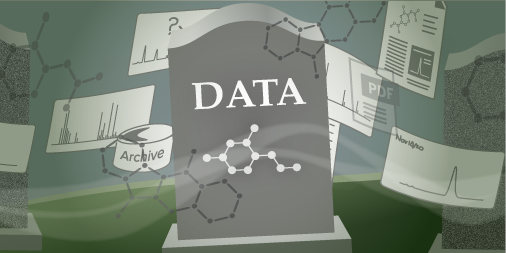October 26, 2023
by Jesse Harris, Digital Marketing Coordinator, ACD/Labs

A haunting curse lingers in the shadowed corridors of analytical chemistry laboratories: the specter of dead data. Just as ancient tombs trap spirits, improper data storage can doom valuable results to a lifeless existence.
But fear not, brave chemist, for this tale will explore the truth behind dead data. This Halloween, we will explore how data “dies” and why you can’t bring it back to life. Not only that, but we will discover the secret of how you can keep your analytical data alive… forever!
What is Dead Data, and Why Does It Die?
Have you ever processed a mass spectrum, an NMR spectrum, or a chromatogram and then exported the data as a peak table, Excel file, or image? If the answer is yes, I am sorry to tell you this, but you might be a data murderer.
File formats like images and spreadsheets are “dead” data because you cannot use it like you would when it was “live.” You cannot reprocess a picture of a chromatogram or review the splitting patterns of an NMR using a list of peaks. These lifeless data types can be used for some applications but lack important information and context that is often necessary for reprocessing and reuse.
Why is all this data dying? Researchers often don’t think they have a choice because analytical data can be challenging to manage. Take the example of trying to solve the structure of an unknown impurity using NMR and mass spectroscopy data. If you are using applications that recognize just one data type, you might have to convert it into a ‘dead’ format for analysis or storage. Unfortunately, that data is now dead.
For an individual researcher working on a solo project, dead data is only a minor problem. If their dead data can’t address a specific question, they can look in their hard drive to find the live results, or the raw data files and then do whatever reprocessing is necessary. This becomes a significant issue in large research organizations, where many people are working on a project, and it is not easy for the person interpreting dead data to hunt down the person who conducted the original experiment.
Can You Revive Dead Data?
The bad news is that once data is dead, it is hard to bring it back to life. Imagine you abstracted a chromatogram into a list of peaks, each with a retention time and area. It should be possible to take that list of peaks and recreate the original chromatogram, right?
Not exactly. This “zombie” chromatogram would not be a recreation of the original. Instead, it would be a visualization of the list of abstracted peaks. This undead chromatogram only looks like it is alive. Treating it like it is alive could get you in trouble—it omits critical details, such as the shape of the peaks or irregularities in the baseline. These details are essential for detecting the presence of unknown impurities or assessing your chromatographic separation’s performance.
How to Stop Dead Analytical Data
How do we prevent our data lakes from becoming data graveyards? Simple, don’t kill your data in the first place! Unfortunately, that isn’t trivial. Scientists don’t kill their data for fun, they do it to accomplish a specific task that they cannot do with their live data.
The solution is to use software that keeps your data alive. The Spectrus® platform allows you to process and store all your analytical data, including NMR, LC, GC, and mass spectroscopy. Spectrus is vendor-neutral, which means it is compatible with all the major equipment vendors. You can work with live analytical data from multiple instruments in the same application without exporting to a dead data format such as an image, spreadsheet, or PDF. This means less time switching between applications and better data quality.
This Halloween, pledge to keep your data alive! Check out the Spectrus platform and ensure your analytical results never face an untimely end.


